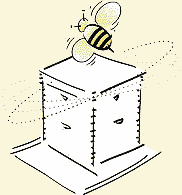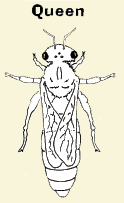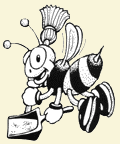 Honey
Bee Facts Honey
Bee Facts
Why
do bees make honey? 
 We
know that bees have been producing honey as they do today for
at least 150 million years. Bees produce honey as food stores
for the hive during the long months of winter when flowers aren't
blooming and therefore little or no nectar is available to them.
European honey bees, genus Apis Mellifera,
produce such an abundance of honey, far more than the hive can
eat, that humans can harvest the excess. For this reason, European
honey bees can be found in beekeeper's hives around the world! We
know that bees have been producing honey as they do today for
at least 150 million years. Bees produce honey as food stores
for the hive during the long months of winter when flowers aren't
blooming and therefore little or no nectar is available to them.
European honey bees, genus Apis Mellifera,
produce such an abundance of honey, far more than the hive can
eat, that humans can harvest the excess. For this reason, European
honey bees can be found in beekeeper's hives around the world!
The Colony
Honey bees are social insects, with a marked
division of labor between the various types of bees in the colony.
A colony of honey bees includes a queen, drones and workers.
The Queen

 The
queen is the only sexually developed female in the hive. She
is the largest bee in the colony. The
queen is the only sexually developed female in the hive. She
is the largest bee in the colony.
A two-day-old larva is selected by the workers
to be reared as the queen. She will emerge from her cell 11 days
later to mate in flight with approximately 18 drone (male) bees.
During this mating, she receives several million sperm cells,
which last her entire life span of nearly two years.
The queen starts to lay eggs about 10 days
after mating. A productive queen can lay 3,000 eggs in a single
day.
The Drones

 Drones
are stout male bees that have no stingers. Drones do not collect
food or pollen from flowers. Their sole purpose is to mate with
the queen. If the colony is short on food, drones are often kicked
out of the hive. Drones
are stout male bees that have no stingers. Drones do not collect
food or pollen from flowers. Their sole purpose is to mate with
the queen. If the colony is short on food, drones are often kicked
out of the hive.
The Workers

 Workers,
the smallest bees in the colony, are sexually undeveloped females.
A colony can have 50,000 to 60,000 workers. Workers,
the smallest bees in the colony, are sexually undeveloped females.
A colony can have 50,000 to 60,000 workers.
The life span of a worker bee varies according
to the time of year. Her life expectancy is approximately 28
to 35 days. Workers that are reared in September and October,
however, can live through the  winter. winter.
Workers feed the queen and larvae, guard the
hive entrance and help to keep the hive cool by fanning their
wings. Worker bees also collect nectar to make honey. In
addition, honey bees produce wax comb. The comb is composed of
hexagonal cells which have walls that are only 2/1000 inch thick,
but support 25 times their own weight.
Honey bees' wings stroke 11,400 times per minute,
thus making their distinctive buzz.
Back to Facts & Fun for Kids
|






